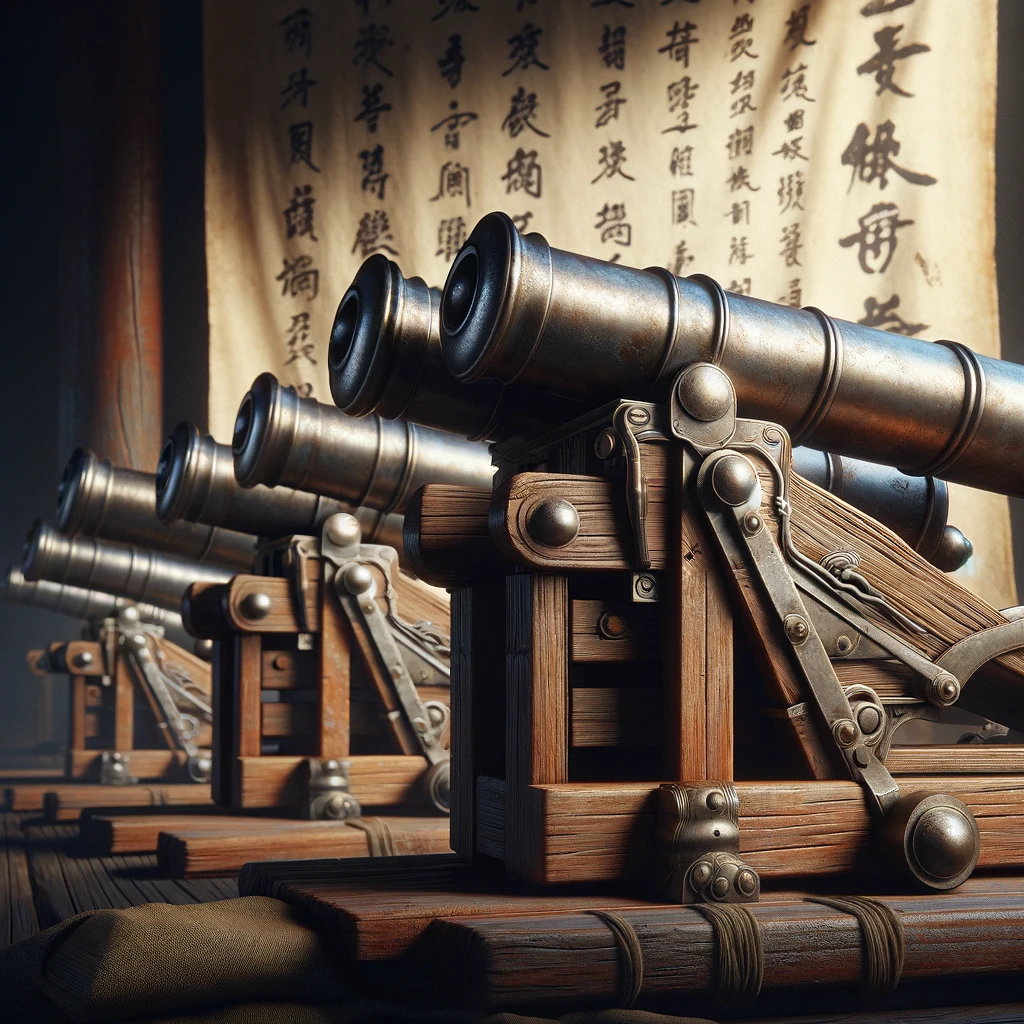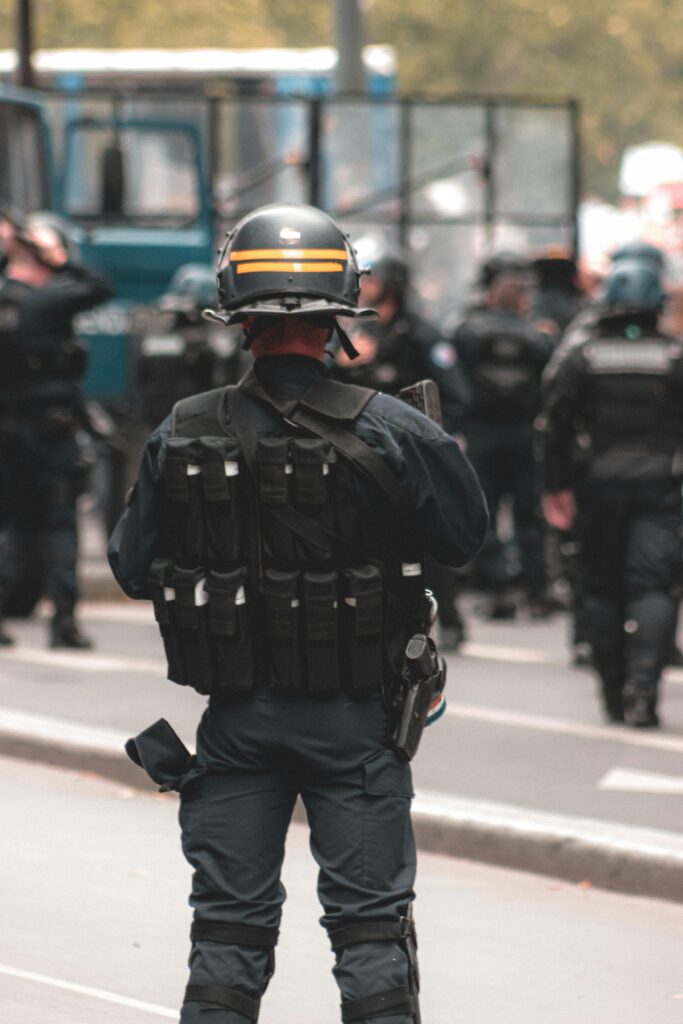From the early days of Chinese black powder through to the full auto machine guns we have to this day, firearms have come a long way over the years.
The history of firearms in warfare begins with the advent of gunpowder, a discovery attributed to Chinese alchemists in the 9th century. Initially used for fireworks and ceremonial purposes, the military potential of gunpowder was soon realized.
The earliest firearms were rudimentary hand cannons, which appeared in China in the 12th and 13th century. These simple tubes mounted on a stick, loaded with gunpowder and projectiles, were the precursors to more sophisticated firearms.
Important Firearms of the 12th and 13th Century
We’re going t try and give you a quick guide to the critical guns. When it comes to the 12th and 13th Century, things were pretty limited to.
1. Chinese Fire Lances
The very first firearms were just bamboo tubes loaded with a projectile, shrapnel, black powder and a short fuse. These were the first firearms and every gun owes its existence to these early trailblazers.
2. Chinese Hand Cannons (Late 13th Century)
Emerging in China, hand cannons are the earliest form of portable firearms. Made from bronze or iron, these tube-like weapons marked the evolution from static siege engines to handheld devices. Soldiers ignited gunpowder charges in the cannon’s rear to launch projectiles. They were revolutionary, but also dangerous to use.
3. Mongolian Fire Arrows
While not firearms in the traditional sense, the Mongols adapted Chinese gunpowder technology to create explosive arrows. These were among the first instances of gunpowder being used in projectile warfare outside China.
4. Early European Gunpowder Use (13th Century)
The formulation and refinement of gunpowder in Europe, influenced by translations of Arabic texts and Chinese technology, laid the groundwork for the continent’s future firearm advancements. Although specific firearms from this era in Europe are not well-documented, the development of gunpowder was crucial for the later invention of cannons and guns in the 14th century.

The Renaissance: Advancements in Firearm Technology
By the 14th and 15th centuries, firearm technology had spread to the Middle East and Europe, where it began to evolve rapidly. The matchlock mechanism, which allowed for easier firing of the weapon, was a significant advancement.
This period also saw the development of the arquebus, a forerunner to the musket, which had a significant impact on infantry tactics. The ability to penetrate armor with a firearm changed the nature of warfare, making heavy armor obsolete and altering the composition of armies.
The Most Important Guns of the 14th and 15th Century
1. Ribauldequin (14th Century)
Also known as the “organ gun,” the Ribauldequin was an early form of volley gun. It consisted of several barrels mounted on a cart, allowing for multiple shots to be fired simultaneously. This innovation was a precursor to the modern machine gun.
2. Bombard (14th Century)
Large, cannon-like weapons, bombards were among the first artillery pieces to use gunpowder. They were primarily used during sieges to breach walls, significantly altering medieval siege warfare.
3. Arquebus (Late 15th Century)
A major step forward from the hand cannon, the arquebus was equipped with a hook-style stock to absorb recoil and a matchlock mechanism for firing, improving accuracy and reliability. It became a standard infantry weapon, gradually replacing bows and crossbows. This was the first rifle and the first really portable firearm. It was one of those guns that changed the world.
4. Culverin (15th Century)
A long, slender cannon, the culverin was designed for greater accuracy and range. This bunker buster was used alongside bombards in sieges and became a staple of European artillery.
5. Matchlock Musket (Late 15th Century)
The introduction of the matchlock mechanism allowed for easier firing of guns, leading to the development of the musket. This innovation was crucial for the future of firearms, enabling soldiers to use guns more effectively in battle.

The Age of Muskets and Rifles
The 17th and 18th centuries saw the widespread adoption of the musket, equipped with a flintlock mechanism, making firearms more reliable and quicker to reload. This era marked the rise of professional standing armies in Europe, where firearms became the dominant weapon on the battlefield. The invention of the bayonet transformed the musket into a dual-purpose weapon, further enhancing its utility.
The 19th century introduced the rifled barrel, greatly improving accuracy and range. The Minié ball, a conical bullet, allowed for faster loading and more devastating effects on the target. These innovations culminated in the widespread use of rifles in conflicts such as the American Civil War, where the devastating power of rifled firearms became fully apparent.
Important Firearms from the 16th-19th Century
1. Wheellock Rifle (16th Century)
The wheellock mechanism provided a more reliable ignition system than the matchlock. This innovation allowed for the development of rifles that could be used by mounted troops and improved the viability of firearms for hunting.
2. Arquebus (16th Century)
Yes it was introduced earlier, but the Arquebus became the go-to firearm in the 16th Century . It became so widespread that it had a ripple effect on military tactics and largely spelled the end of heavy cavalry. Which animal lovers will appreciate…
3. Snaphance and Flintlock Muskets (16th-17th Century)
The snaphance and later the flintlock mechanism revolutionized firearms, offering a quicker and more reliable means of ignition. Flintlock muskets became the main infantry weapon and were used extensively in European conflicts and colonial wars.
4. Blunderbuss (17th Century)
Known for its distinctive flared muzzle, the blunderbuss was used for close combat and defense on ships. Its ability to fire multiple projectiles made it particularly effective in naval boarding actions and crowded battlefields.
5. Brown Bess Musket (Late 17th-18th Century)
The British Army’s standard-issue firearm for over a century, the “Brown Bess” was a flintlock musket that saw action across the globe, from the American Revolutionary War to the Napoleonic Wars.
6. Kentucky Rifle (18th Century)
The American-made Kentucky rifle featured a longer barrel and rifled bore, offering greater accuracy over long distances. It became a symbol of American frontier spirit and was crucial in the American War of Independence.
The Revolution of Automatic Weapons
The late 19th and early 20th centuries heralded the advent of automatic firearms, transforming warfare yet again. The invention of the machine gun, capable of delivering sustained rapid fire, had a profound impact on World War I, leading to trench warfare and unprecedented casualties. The development of semi-automatic and automatic rifles enhanced infantry firepower, allowing for more mobile and flexible tactics.
World War II saw the refinement of these technologies, with the widespread deployment of submachine guns, assault rifles (notably the German StG 44, considered the first modern assault rifle), and improved machine guns. These weapons increased the rate of fire and lethality on the battlefield, emphasizing mobility and firepower.
That led to the AK-47 and AR-15 rifles that we see to this day.
The Modern Era: Precision and Power
The late 20th and early 21st centuries have seen significant advancements in firearm technology, with a focus on precision, range, and lethality. The introduction of precision-guided firearms, advanced optics, and night-vision equipment has transformed the modern battlefield, allowing for engagements at greater distances and with higher accuracy.
The development of personal defense weapons (PDWs) and the continuing evolution of assault rifles reflect the ongoing quest for the optimal combination of firepower, accuracy, and mobility.
Most Important Firearms of the 20th and 21st Century
1. Maxim Gun (Late 19th/Early 20th Century)
Although invented in the late 19th century, the Maxim gun, the first fully automatic machine gun, revolutionized warfare in the early 20th century. it paved the way for the devastating fully automatic machine guns that would soon hit the spotlight. It was the first machine gun, although it had a fairly agricultural action.
2. M1911 Pistol (20th Century)
Designed by John Moses Browning, the M1911 semi-automatic pistol changed the handgun world forever. It was almost immediately adopted by the US military and remains popular to this day.
3. AK-47 (Mid 20th Century)
Developed by Mikhail Kalashnikov in the late 1940s, the AK-47 assault rifle is renowned for its durability, simplicity, and widespread use across various military forces and insurgent groups globally.
4. M16 Rifle (Mid 20th Century)
Introduced during the Vietnam War, the M16 became the standard issue assault rifle for the US military, notable for its lightweight design and the use of the high-velocity 5.56mm cartridge.
5. Uzi Submachine Gun (Mid 20th Century)
The Uzi, designed by Uziel Gal, became one of the most recognized and widely used submachine guns, favored for its compact size and reliability.
6. Browning Machine Gun
This vehicle mounted machine gun changed the face of warfare in the 20th Century. Fitted to ships, Jeeps and even helicopters, this allowed the military to strafe the countryside with 50 caliber rounds.
The Impact of Firearms on Warfare
The history of firearms in warfare is a testament to human ingenuity. Each advancement in firearm technology has prompted adaptations in tactics and strategy, often leading to profound changes in the conduct of warfare. The introduction of firearms led to the decline of mounted knights and castles, shifted the balance of power from feudal lords to central governments, and eventually enabled the rise and fall of nation-states.
Firearms have also impacted the scale and scope of conflicts, enabling global wars with devastating consequences. The quest for superiority in firearm technology continues to drive military innovation, reflecting the complex interplay between technology, strategy, and human conflict.
Conclusion
The history of firearms in warfare is a narrative of continuous innovation and adaptation. From the simple hand cannons of the 13th century to the sophisticated, precision-guided firearms of today, the evolution of firearms has been inextricably linked with the history of human conflict.
As technology advances, so too will the nature of warfare, with firearms likely to remain at the heart of military strategy and tactics for the foreseeable future. This journey through history underscores not only the transformative power of technology in warfare but also the enduring quest for security and dominance in the human experience.


